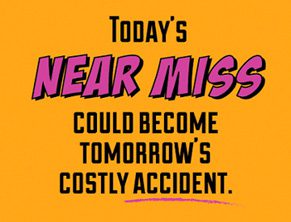Near misses, or close calls, are events that didn’t harm anyone — but could have. They are not accidents, but they could have been accidents if the circumstances had been slightly different. Near misses happen more often than you might think and might be as simple as dropping a tool from a lift or ladder. They are easy to forget and are often forgotten quickly.

OSHA defines a near miss as incidents “in which a worker might have been hurt if the circumstances had been slightly different.” They are a precursor to accidents and are opportunities to identify hazards and unsafe conditions.
It goes without saying that reporting near misses is a critical tool to create solutions, prevent accidents and injuries in the future and improve our safety culture overall.
There are two main types of near miss incidents — an unsafe condition near miss and an unsafe act near miss:
- Unsafe Condition – Circumstances, the environment, or a state of equipment which could lead to an accident occurring. It may include things like the guardrails missing at the elevator pit on the third floor and nobody has put them back in place.
- Unsafe Act – Behavior that can potentially lead to damage of property, personal injury, or death; it is often related to ignoring procedures and is signaling the need for new rules. The employee standing on the top rung of a ladder is obviously an unsafe act.
Near misses should be looked at closely, in either case, and we must take the time to correct the problems we encounter daily — and learn from any near miss that we have experienced.
As the picture indicates above, a near miss could result in an accident and an injured worker tomorrow.
Please notify the Safety department if you believe there was a near miss on your project.
Until next time—work safe and be safe!




